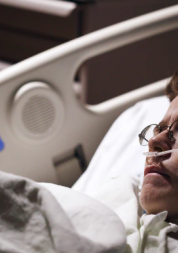Improvements needed at Queen's Hospital maternity services following CQC inspection

CQC carried out an unannounced focused inspection to look at the safety and well-led aspects of the hospital’s maternity services in June. This was due to concerns raised about the safety and quality of the maternity services, especially how the service was organised and the culture of the department.
Following this inspection, the maternity services rating has dropped from good to requires improvement overall. It was also rated as requires improvement in relation to whether it was well-led. The ratings of good for effective, caring and responsive remain from the previous inspection.
Nigel Acheson, CQC’s deputy chief inspector for hospitals, said:
“We inspected the maternity services at Queen’s Hospital as we had concerns about the quality of services being provided. We were not assured that women were receiving a safe service. We were also concerned about the negative impact the culture in the department was having on staff, and the resulting effect it had on the quality of services being provided.
“The trust was not learning from incidents in order to improve care in the future. There were unclear processes around how the department was logging, assessing, learning and sharing information around incidents. This lack of learning meant some incidents were repeated as there had been no steps taken to mitigate ongoing potential risks to women and their babies.
“This was also compounded by the fact that staff did not always feel able to speak out about concerns. They also told inspectors that even when they did, they didn’t always receive feedback or were told what, if any action had been taken as a result of raising these concerns. These are missed opportunities to improve the care being provided to the people using these services.
“Staff also told us that they did not feel supported or listened to by senior leaders and there was a poor culture in the department which included bullying.
“However, the trust has started to take action to address this, including requesting support from the organisation's psychologist, and appointing an obstetric lead to tackle the culture within the medical team.
“Following our inspection, we informed the trust leadership team of our findings. They told us that significant and immediate improvements would be made to ensure the safety of patients.
“We will continue to monitor the service and expect to see sustainable improvements the next time we inspect.”
Inspectors rated the service requires improvement for the following reasons:
- Staff did not always complete risk assessments for women and identify women at risk of deterioration using the maternity early obstetric warning tool.
- The service did not always complete venous thromboprophylaxis (VTE) assessments, which is a check for blood clots, for women being admitted to the antenatal ward.
- Staff did not always refer to the psychological and emotional needs of women during shift handovers.
- The service did not always record consultant attendance to patients suffering from post-partum haemorrhage so there was no assurance they attended at every event.
- Cardiotocography, or the continuous recording of the fetal heart rate obtained via ultrasound was not always reviewed by a second independent midwife.
- Inspectors found some examples of out of date guidance in use within the service.
- Not all staff had received multidisciplinary training at the time of the inspection and the service was projected to be noncompliant by the deadline set by Clinical Negligence Scheme for Trusts.
- When things went wrong, the lessons learned from mistakes made were not always shared with staff.
- Leaders did not always run services well using reliable information systems and support all staff to develop their skills.
- Staff did not always feel respected, supported and valued by their leadership team.
However, inspectors also found:
- Staff were trained to keep people safe and protect women from abuse. Staff also knew how to refer women for specialist support.
- There was an assessment tool in place to triage women calling into the service for advice and support.
- The service managed surgical site infections well with performance being above the national average.
- There was emergency consultant anaesthetist cover 24 hours a day seven days a week.
- Staff responded quickly to emergencies and communicated effectively with other teams.
- There were multidisciplinary handovers twice a day to discuss patients with staff coming onto shift.
- Systems and processes were used safely to prescribe, administer, record and store medicines.
Notes to editor
Throughout the COVID-19 pandemic, the CQC’s regulatory role has not changed. CQC’s core purpose of keeping people safe is always driving decisions about when and where we inspect. As the risks from the pandemic change, we are evolving how we regulate services to reflect what we have learnt during this time. You can read more about our current approach on our website.
CQC is listening to what people are saying about services to help detect any changes in care. If there is evidence people are at immediate risk of harm, CQC can and will take action to ensure that people are being kept safe. People can give feedback about their care to CQC via the details below.
Give feedback via the website
Telephone - 03000 616161
Contact
For media enquiries:
- John Scott, Regional Engagement Manager - 07789 875809 - john.scott@cqc.org.uk or
- Nicki Dallison, Regional Engagement Officer – 07385 373968 - nicki.dallison@cqc.org.uk
- Alternatively you can email regional.engagement@cqc.org.uk
- Journalists wishing to speak to the press office outside of office hours can find out how to contact the team on the website.
About the Care Quality Commission
The Care Quality Commission (CQC) is the independent regulator of health and social care in England. We make sure health and social care services provide people with safe, effective, caring, well-led and responsive care, and we encourage care services to improve. We monitor, inspect and regulate services to make sure they meet fundamental standards of quality and safety and we publish what we find to help people choose care.

